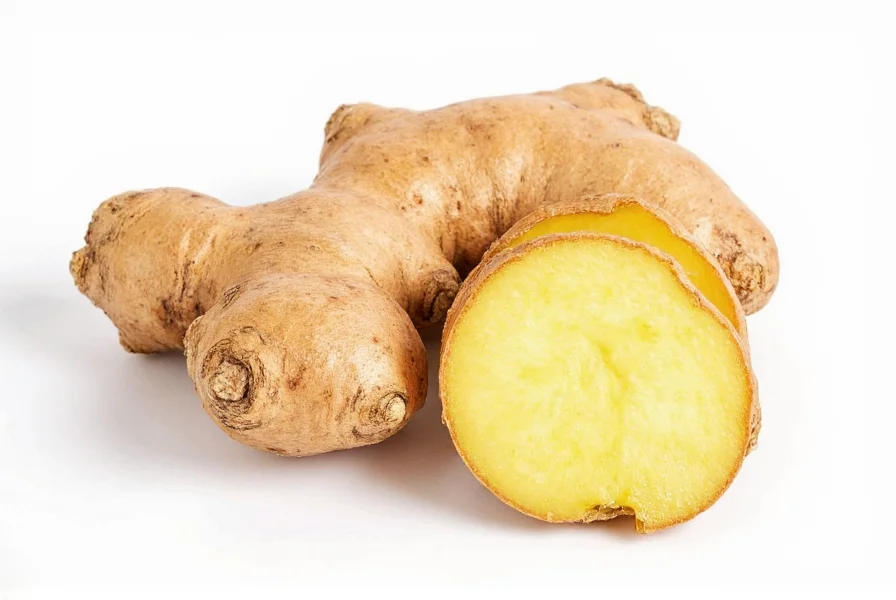Ginger isn't just a kitchen staple—it's a botanical powerhouse with documented health benefits and culinary versatility. This ancient root has journeyed from Asian forests to global kitchens, maintaining its status as one of the world's most researched medicinal plants. Let's explore the science-backed facts that make ginger a remarkable addition to your diet.
Nutritional Profile of Ginger Root
Despite its small serving size, ginger packs a nutritional punch. A single tablespoon (13g) of raw ginger contains:
| Nutrient | Amount | % Daily Value |
|---|---|---|
| Calories | 4 | 0.2% |
| Carbohydrates | 1g | 0.3% |
| Fiber | 0.1g | 0.4% |
| Vitamin B6 | 0.01mg | 0.6% |
| Vitamin C | 0.3mg | 0.5% |
| Magnesium | 1.2mg | 0.3% |
What makes ginger nutritionally significant isn't its macronutrient profile but its potent bioactive compounds. Gingerol, the primary bioactive substance, gives ginger its distinctive flavor and accounts for many of its health-promoting properties. Research published in the International Journal of Preventive Medicine confirms that gingerol exhibits strong anti-inflammatory and antioxidant activities.

Historical Journey of Ginger
Ginger's story begins in Southeast Asia, where it grew wild before being cultivated over 5,000 years ago. Ancient Sanskrit and Chinese texts document ginger's use in traditional medicine systems. By the 1st century CE, ginger had reached the Mediterranean through Arab traders, becoming so valuable that a pound of ginger cost as much as a sheep in 13th century England.
The spice played a crucial role in global exploration—Christopher Columbus carried ginger on his voyages, and it was among the first crops planted in Jamaica after European colonization. This historical context explains why ginger features prominently in diverse culinary traditions from Indian curries to Jamaican ginger beer and Japanese pickled ginger.
Scientifically Supported Health Benefits
Unlike many herbal remedies with limited evidence, ginger has substantial scientific backing for specific health applications:
Nausea Relief
A comprehensive review in Obstetrics & Gynecology analyzed 12 studies involving over 1,200 pregnant women. The conclusion: ginger significantly reduces pregnancy-related nausea without adverse effects on pregnancy outcomes. The American College of Obstetricians and gynecologists now considers ginger a first-line treatment for morning sickness.
Inflammation Reduction
Research in Arthritis & Rheumatism demonstrated that ginger extract reduced osteoarthritis knee pain by 30% compared to placebo. The anti-inflammatory effects appear comparable to mild NSAIDs but without gastrointestinal side effects.
Digestive Health
Studies show ginger accelerates gastric emptying by 25%, which explains why many cultures consume ginger before or after meals. This effect makes it particularly valuable for people with functional dyspepsia.

Practical Applications in Modern Kitchens
Ginger's versatility extends far beyond tea for upset stomachs. Professional chefs and home cooks utilize ginger in three primary forms:
- Raw ginger: Adds sharp, spicy notes to stir-fries, marinades, and salad dressings
- Ground ginger: Provides warm, earthy flavor in baked goods and spice blends
- Candied ginger: Offers sweet-spicy complexity in desserts and cocktails
For maximum flavor impact, grate ginger finely using a microplane. The white part just beneath the skin contains the highest concentration of gingerol. When substituting between fresh and dried forms, remember that 1 tablespoon fresh ginger equals approximately 1/4 teaspoon ground ginger due to concentration differences.
Common Misconceptions Debunked
Despite its popularity, several myths persist about ginger:
- Myth: Ginger thins blood significantly
Fact: While ginger has mild antiplatelet effects, research in Thrombosis Research shows it doesn't increase bleeding risk at culinary doses (under 4g daily) - Myth: All ginger supplements are equally effective
Fact: Standardized extracts containing 5% gingerols provide consistent results, while many commercial products vary widely in active compound concentration - Myth: Ginger causes heartburn
Fact: Studies show ginger actually reduces heartburn symptoms by accelerating gastric emptying
Storage Techniques for Maximum Freshness
Proper storage dramatically extends ginger's shelf life:
- Store unpeeled ginger in an airtight container in the refrigerator's crisper drawer for up to 3 weeks
- Freeze whole ginger root for up to 6 months—grate frozen without thawing
- Submerge peeled ginger in sherry or vodka in the refrigerator for up to 1 month
When selecting ginger, choose firm roots with smooth skin and minimal wrinkles. The best ginger has a spicy, citrusy aroma when scratched—avoid roots with soft spots or mold.
Responsible Consumption Guidelines
While generally safe, ginger requires moderation in specific circumstances:
- Limit to 1g daily during pregnancy (consult your healthcare provider)
- Avoid exceeding 4g daily from all sources (food and supplements combined)
- Discontinue use 1 week before surgery due to potential interactions with blood thinners
- People with gallstones should consult a physician before regular consumption
Most adults experience no side effects with moderate culinary use (0.5-1.5g daily). Higher doses may cause mild heartburn or mouth irritation in sensitive individuals.
Conclusion: Ginger's Enduring Legacy
Ginger represents one of the most well-documented botanicals in both traditional medicine and modern science. Its journey from ancient Asian remedy to evidence-based therapeutic agent demonstrates how traditional knowledge can align with contemporary research. Whether you're using it to soothe an upset stomach, add complexity to dishes, or potentially reduce inflammation, ginger remains a kitchen essential with scientifically validated benefits. As research continues, we're likely to discover additional applications for this remarkable rhizome while appreciating its centuries-old legacy.
What is the most effective way to consume ginger for nausea relief?
For nausea relief, fresh ginger consumed as tea or crystallized ginger provides the most immediate effects. Studies show 1g of fresh ginger (about 1/2 inch slice) consumed 20 minutes before potential nausea triggers works best. The active compounds are more bioavailable in raw form compared to cooked or processed versions.
Can ginger interact with medications?
Ginger may interact with blood thinners like warfarin due to mild antiplatelet effects, though significant interactions are rare at culinary doses (under 1g daily). It may also enhance diabetes medications' effects. Always consult your healthcare provider if taking prescription medications, especially before consuming ginger supplements exceeding 1g daily.
How does ginger compare to other anti-inflammatory foods?
Ginger's anti-inflammatory potency is comparable to turmeric but works through different mechanisms. While turmeric primarily inhibits COX-2 enzymes, ginger blocks multiple inflammatory pathways. Research suggests combining ginger with black pepper increases its bioavailability by 2000%, similar to turmeric with piperine. Unlike NSAIDs, ginger doesn't cause gastrointestinal damage at therapeutic doses.
Does cooking destroy ginger's beneficial compounds?
Cooking transforms but doesn't eliminate ginger's beneficial compounds. Heating converts gingerol to shogaol, which has even stronger antioxidant properties. While some volatile compounds diminish with prolonged cooking, research shows that even cooked ginger retains significant anti-inflammatory activity. For maximum benefit, add ginger toward the end of cooking rather than at the beginning.
How much ginger is safe to consume daily?
For most adults, up to 4g of ginger daily from all sources (food and supplements) is considered safe. Culinary use typically involves 0.5-1.5g daily, which rarely causes side effects. Pregnant women should limit intake to 1g daily. Higher doses may cause heartburn or mouth irritation in sensitive individuals. Always consult a healthcare provider before exceeding 1g daily if you have medical conditions or take medications.
Frequently Asked Questions
What is the most effective way to consume ginger for nausea relief?
For nausea relief, fresh ginger consumed as tea or crystallized ginger provides the most immediate effects. Studies show 1g of fresh ginger (about 1/2 inch slice) consumed 20 minutes before potential nausea triggers works best. The active compounds are more bioavailable in raw form compared to cooked or processed versions.
Can ginger interact with medications?
Ginger may interact with blood thinners like warfarin due to mild antiplatelet effects, though significant interactions are rare at culinary doses (under 1g daily). It may also enhance diabetes medications' effects. Always consult your healthcare provider if taking prescription medications, especially before consuming ginger supplements exceeding 1g daily.
How does ginger compare to other anti-inflammatory foods?
Ginger's anti-inflammatory potency is comparable to turmeric but works through different mechanisms. While turmeric primarily inhibits COX-2 enzymes, ginger blocks multiple inflammatory pathways. Research suggests combining ginger with black pepper increases its bioavailability by 2000%, similar to turmeric with piperine. Unlike NSAIDs, ginger doesn't cause gastrointestinal damage at therapeutic doses.
Does cooking destroy ginger's beneficial compounds?
Cooking transforms but doesn't eliminate ginger's beneficial compounds. Heating converts gingerol to shogaol, which has even stronger antioxidant properties. Research shows that even cooked ginger retains significant anti-inflammatory activity. For maximum benefit, add ginger toward the end of cooking rather than at the beginning.
How much ginger is safe to consume daily?
For most adults, up to 4g of ginger daily from all sources (food and supplements) is considered safe. Culinary use typically involves 0.5-1.5g daily, which rarely causes side effects. Pregnant women should limit intake to 1g daily. Higher doses may cause heartburn or mouth irritation in sensitive individuals. Always consult a healthcare provider before exceeding 1g daily if you have medical conditions or take medications.











 浙公网安备
33010002000092号
浙公网安备
33010002000092号 浙B2-20120091-4
浙B2-20120091-4